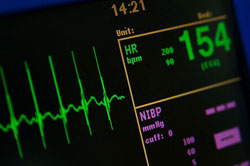Vital Signs
Student pages
 Vital signs are measurements that indicate a person’s state of health. They help to give a quick overview of basic body functions and can be a symptom of a disease or illness in the body. Paying close attention to a patient’s vital signs can sometimes be a good clue to diagnosing the health problem.
Vital signs are measurements that indicate a person’s state of health. They help to give a quick overview of basic body functions and can be a symptom of a disease or illness in the body. Paying close attention to a patient’s vital signs can sometimes be a good clue to diagnosing the health problem.
Keep in mind when reading the descriptions below that vital signs can vary with age, gender, weight, physical fitness, disease conditions, and even your source of information. (Not all sources agree on the exact numbers, but all are in the same range of numbers for normal values.) The measurements presented here are averages for adults.)
Vocabulary
Apical pulse— the pulse heard when listening to the heartbeat through a stethoscope.
Blood pressure—the force exerted on the inside of the artery walls by blood pumped by the heart.
Brachial artery—the artery in the upper arm near the elbow.
Bradycardia—a slow pulse rate
Diastolic pressure— the pressure of blood against the inside arterial walls when the heart is at rest.
Hypertension—high blood pressure
Hypotension—low blood pressure
Pulse rate— the number of times the heart beats per minute.
Radial artery—the artery in the wrist used most often to take a pulse measurement.
Respiration rate—the number of breaths per minute.
Stethoscope—a medical instrument used to magnify sounds coming from inside the body.
Sphymomanometer—a medical instrument
Systolic pressure— the pressure of blood against the inside of arterial walls when the heart contracts.
Tachycardia—a rapid heart rate.
Temperature—a measure of heat in a living body.
The four measurements that are generally considered to be vital signs are:
1) Body temperature
Normal body temperature varies with gender, activity, and time of day and can range from 97.8° F (Fahrenheit) to 99° F (or 36.5° to 37.2° Celsius)
How to measure body temperature
Temperatures can be measured orally, rectally, axially (at the armpit) or in the ear. Temperatures taken rectally are usually 0.5—0.7° F higher than temperatures taken by mouth. Temperatures taken axially are generally 0.3—0.4° F lower than temperature taken by mouth.
An elevated temperature usually indicates a possible infection.
2) Pulse
Pulse is produced as the heart pushes blood through arteries. Arteries have thick, muscular walls which can contract and help push the blood though the body along the circulatory route away from the heart.
The pulse rate is a reflection of the number of times the heart beats per minute. Taking a pulse rate measures not only the beats per minute, but can also show heart rhythm and pulse strength.
The normal pulse rate for adults is 60—100 beats/minute. Pulse rates vary with exercise, illness, injuries, emotions, or stress.
To measure pulse rates
• For convenience, pulse rates are usually measured using the radial (at the wrist) artery.
• Find the radial artery located on the ventral side of the wrist, down from the thumb. You may need to move your fingers up or down the wrist area to find the pulse.
• Place your index finger and middle finger over the artery and count the beats for 30 seconds and multiply by 2. This will give the beats/minute. You can also count for 15 seconds and multiply by 4, but this is not as accurate. Do not use your thumb to take a pulse measurement because the thumb also has a pulse and this will give inaccurate readings.
For example, a measurement of 40 beats in 30seconds would mean a pulse rate of 40 X 2 = 80 beats per minute.
A measurement of 15 beats in 15 seconds would mean a pulse rate of
15 X 4 = 60 beats per minute.
• If the rate is very slow or very fast, count for the full 60 seconds to obtain an accurate measurement.
• At the same time, note the regularity of the beats. The heartbeat should be very regular, but some irregularities are quite common and do not represent any serious health issue. Completely irregular rhythms and extra beats should be investigated in more detail.
If you can not find the radial pulse, a pulse rate can be taken over the carotid artery (one on each side of your neck). Do not push too hard on the carotid artery, as this artery carries oxygenated blood to the brain; a light touch should be all that is needed.
The apical pulse is taken by listening to the heart beat through a stethoscope.
A fast pulse (tachycardia) could indicate fever, anemia (too few blood cells), dehydration, drugs, such as caffeine, nicotine, or cocaine, or a variety of heart conditions, or just excitement or anxiety.
A slow pulse (bradycardia) could be caused by medications such as some high blood pressure drugs or a variety of heart conditions. Athletes may also have slow heart rates because their improved physical condition makes their hearts more efficient at slower rates.
3) Blood pressure
Blood pressure is the force exerted on the inside of the artery walls by blood pumped by the heart. You measure blood pressure over arteries and not over veins because the thicker, muscular walls of arteries help to push blood through the circulatory system as it moves away from the heart. Veins carrying blood returning to the heart are thin-walled, and do not pulse.
Health and Medicine Photodisc Vol.18 18009.pdf
To measure blood pressure:
Blood pressure is measured with a blood pressure cuff, or sphygmomanometer, and a stethoscope. There are many electronic blood pressure cuffs with digital readouts that accurately measure blood pressure. These are much easier to use than the traditional blood pressure cuffs with dials or columns of numbers, but they may not always be accurate enough. If you need a very accurate blood pressure reading, make sure you are getting an accurate measurement from your digital monitor by checking the reading with another cuff, if possible.
• Place the cuff on the person’s arm with the monitor over the brachial artery (on the side of the upper arm nearer to the body and by the elbow.)
• Place the stethoscope under the cuff and over the artery.
• Watching the dial or column, inflate the cuff until the needle or column of fluid is OVER 200. Inflating to just over 200 is usually enough for every patient. If you know the patient is likely to have low blood pressure, you would not have to inflate the cuff as much.
• Slowly, let out a steady stream of air from the cuff as you watch the dial or the column of fluid move over the numbers.
• You are looking for the FIRST number at which you hear the FIRST heartbeat and the LAST number at which you hear the LAST heartbeat.
The higher number is the systolic pressure, or the pressure of blood against the inside of the arterial walls when the heart contracts.
The lower number is the diastolic pressure, or the pressure of blood against the inside of the arterial walls when the heart is at rest.
Normal blood pressure is less than 120mm Hg /less than 80 mmHg.
High blood pressure (hypertension) can be caused by the narrowing of arteries due to fat deposits or a fast heartbeat. A variety of heart conditions can also cause high blood pressure, as can some medications, but often the reason is not known. There is a strong genetic link to having high blood pressure.
High blood pressure can not usually be cured, but it can be treated and controlled. It is important to monitor and receive treatment for high blood pressure. Hypertension increases the risk of coronary heart disease, stroke, kidney disease, and blindness. Untreated high blood pressure can result in irreversible heart damage.
Blood pressure is considered high if the reading is 140 mmHg or higher/90 mmHg or higher.
Blood pressure is considered pre-hypertensive if the reading is 120mmHg—139 mmHg/80 mm Hg—89 mm Hg
Low blood pressure (hypotension) can be caused by pregnancy, medications, heart problems (low pulse rate, heart valve problems, heart attack and heart failure), diabetes, thyroid gland problems, dehydration, blood loss from injury, severe infection, or severe allergic reactions.
Blood pressure is considered low if it is lower than 90 mm Hg/ lower than 60 mm Hg. It is usually much more difficult to diagnose low blood pressure than high blood pressure because what is low for one person may be normal for another. Health care practitioners usually consider the absence or presence of symptoms before confirming a low blood pressure diagnosis.
4) Respiration Rate
The respiration rate is the number of breaths in one minute.
How to measure respiration rates
Respiratory rates are measured by counting the number of times the patient’s chest rises in one minute or in 30 seconds and multiplied by 2. Patients are usually not aware of the procedure because it may be possible for them to control the breaths taken. It is usually done when the pulse is taken because the health practitioner is already timing heartbeats per minute. It is an easy jump to watch the number of times the chest rises.
The regularity of the breaths is also noted, along with the type of breaths taken (shallow, deep, wheezy, or painful, for example).
The normal respiration rate is 15—20 breaths per minute, but varies depending on the source of information.
Some medical personnel say that respiration rates are not good indicators of disease, except possibly, with the exception of some heart disease conditions which also present a greatly lowered blood oxygen level. In this condition, respiration rates are higher than normal.
Note: Some medical personnel use pain as a “fifth vital sign”. Patients rate their discomfort of a scale of 0—10. Other medical personnel say that pain is a subjective description and while they may use the rating to obtain more information from the patient, they do not classify pain as one of the vital signs of patient body function.
Still others use blood oxygen levels or pupil size as the fifth vital sign.





